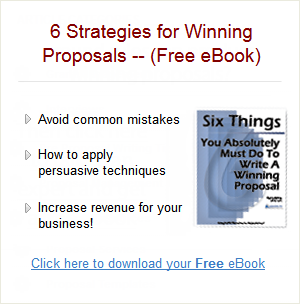Recognize the Significance of Your Proposal
BOOST SUCCESS BY TREATING PROPOSAL WRITING AS A STRATEGICALLY IMPORTANT PROJECT
The state and local government IT market is huge: More than $100 billion was spent in 2000 by states, cities and counties on information systems and services. And part of this market — the world of outsourcing, systems integration, consulting and hundreds of different value-added IT services — can only be captured by submitting a proposal.
Yet proposal writing is not regarded as an important activity by many leading IT firms. They simply do not see proposal writing as part of their core business, despite the size of the market and its strategic impact.
| FAST FACTS
Proposal Pointers Devote adequate staff and give them access to senior people. Include seasoned management, technical and legal personnel in a review capacity. Make your proposal easily understandable for evaluators. |
These firms, whose core competence often includes superb project management skills, fail to recognize that producing a proposal is just another project. It may be very important; it may be strategic; your job may depend on the results. But it is still just another project. As a project, the final deliverable is a winning proposal — one that provides persuasive evidence that your firm understands the problem; has a sound solution; possesses the skills and experience to do the work; and can provide the solution at a reasonable, or at least acceptable, cost.
Steps to Success
Some IT firms chronically fail at producing winning proposals. Their proposals mirror the industry’s problems with other types of projects: The development cycle is too long. The deliverable is produced too late. Cost overruns are common. The product is poor in quality.
Other IT firms know that producing a winning proposal is not very different than completing a systems integration project successfully. The critical success factors are strikingly similar:
- Assemble a team of skilled people: Proposal writing involves more than simply repackaging the RFP information and adding a few resumes. It is a demanding exercise requiring a variety of skills related to technical expertise, project management, marketing, sales, legal issues and pricing. It requires knowledge of the buyer’s organization and its environment.
- Employ a proven methodology: Winning proposals are the result of a planned, organized and controlled process. The process is based on a standardized project plan incorporating checkpoints, interim deliverables and quality control. At several times in the process, the “bid/no bid” decision is re-evaluated. It’s better to “no bid” than to submit a proposal which damages your firm’s credibility and prejudices future sales.
- Incorporate good intelligence in your proposal and plans: Winning proposals differentiate you from your competition. They prove not simply that you can do the job, but that you can do it better. Doing this requires solid information concerning your company’s strengths and weaknesses as well as those of your competitors. Many organizations use the RFP’s evaluation criteria as a template to identify their strengths and weaknesses compared to the likely competition. Other organizations develop strategies for competing against specific firms and incorporate those strategies into all appropriate proposals.
- Adopt appropriate tools: Few proposals are created from scratch. It takes too long and ignores the investment that has been made in old proposals. Many firms maintain a library, either real or virtual, of their old proposals. Some regularly review their marketplace and the competition and modify their marketing and sales approach. Others develop proposal writing software to assist in managing and producing proposals.
- Leverage your firm’s experience: Proposal strategy is often developed by one or two individuals who know the organization issuing the RFP, the marketplace and the vendor’s competitive position. Winning proposals reflect competence, usually based on closely-related experience. Including seasoned management, technical and legal staff in a review capacity can often mean the difference between winning and placing second.
Effective Communication
Implementing these techniques, especially adopting quality control reviews and checkpoints, will help ensure that your proposal is sound. However, even that isn’t enough! Your proposal also must be easily grasped by the evaluators. When creating proposals, many organizations seem to forget this grade-school lesson: For effective communication, your words must be understood.
Allow me to illustrate:
While developing this column, I was interrupted by my 10-year-old son, Daniel, who wanted to know what I was writing. During the resulting conversation, I asked him what a proposal was. He replied, “It’s something you are going to do — like a knight says to the king, ‘I propose to kill the dragon.’ ”
We then discussed how to write a good proposal or a good article. Here’s his advice (which isn’t much different than mine): “Write the proposal for the person you are proposing it to. You have to write it so a normal person can read it. For a complicated proposal, write it for people with experience and knowledge.”
His final words on the topic were: “Use language that they know. You can’t write a letter to the Korean government in English, only in Korean!”
From Type A to Type B
When it comes to creating proposals, I have found that there are two distinct types of firms.
Type A firms fail to recognize the importance of proposal writing. Therefore, it is expensive, inefficient, frustrating and difficult. It’s done in an environment with few people available, little access to senior personnel for pricing and policy decisions, and insufficient time.
On the other hand, Type B firms recognize proposal writing as a strategic activity. In these firms, proposal writing is cost-effective, disciplined, and well managed. It’s done in an environment with adequate resources, dedicated staff and access to senior people. Simply put, management recognizes the critical success factors for winning competitions.
Moving from Type A to Type B is simple. Recognize the critical success factors; invest money and effort for re-tooling, adequate staff and training; and, most importantly, treat the production of your next proposal as a strategically important project

